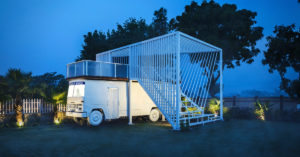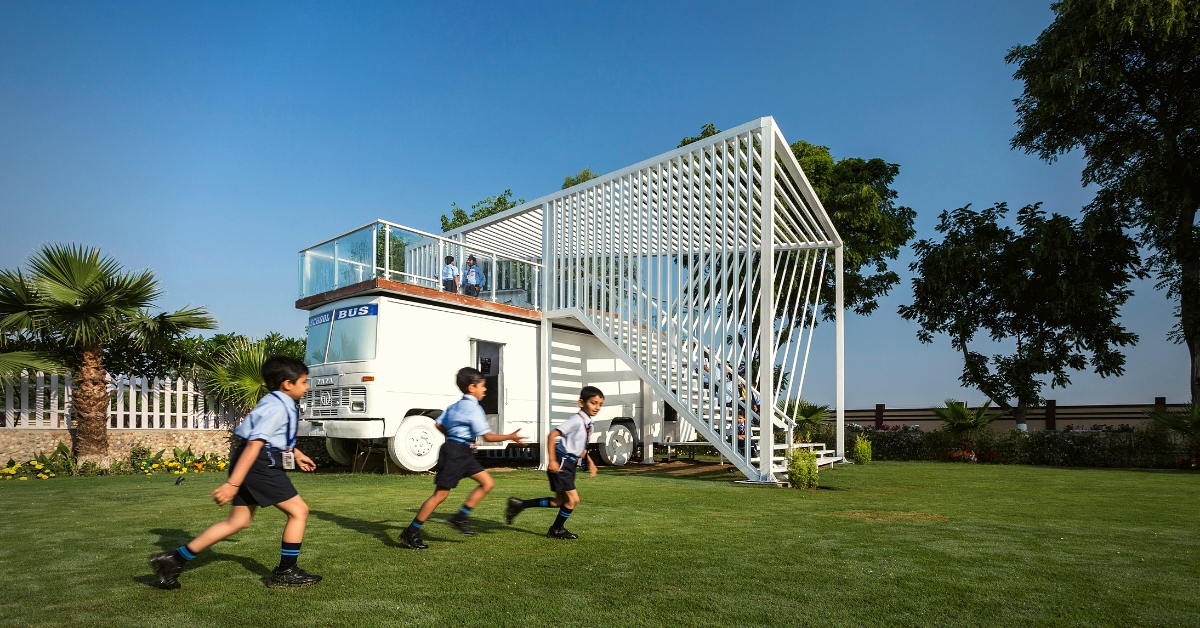Tucked away in Parowal, a small village of Punjab, there is a school with a unique structure that redefines the meaning of upcycling. Made of metal and concrete and infused with love and character, this multipurpose construction is winning worldwide recognition.
“Most people, when talking about recycling, move towards complete dismantling of the existing entity to create something new. While many objects may require it, in this case, we were faced with the challenge of maintaining the original essence of the object, while creating something new,” Prerna Kaleru, design director at Studio Ardete, tells The Better India (TBI).
Not willing to part with a bus from the first fleet that the school had acquired two decades ago, the collaboration of Ardete and Doaba Public School (DPS) gave rise to Bavillion- an upcycled geometric bus-pavilion in the school premises that serves as an open-air theatre, play area as well a museum!

Owing to its novelty, the Bavillion was also nominated for the prestigious Eurasian Prize – Architecture and Design Award. But, the origin of the globally acclaimed project comes from one of the most grounded emotions-nostalgia.
Preserving history and emotions
In 2017, DPS Parowal decided to retire its 20-year-old bus. This bus belonged to the first fleet of school buses that the founders bought on loan owing to the rising number of students in the school. Now with over 2500 students from more than 100 villages, the school has a fleet of 50 buses, making the retirement of the old bus inevitable.
However, parting ways with a piece of their history was not something the school wanted, so they approached Studio Ardete to reuse and create something out of the bus without eliminating its basic structure.
“The bus had already lived its cycle and had to be disposed of, but as it was special, the school reached out to us to design a way to preserve it while making it useful again,” said Prerna.
“Structures and spaces also need to breathe. Making them come alive is what we strive for. And the challenge of this project was entirely in line with this ideal. We knew that we needed to keep the basic shape of the vehicle intact while working around it. We even kept the steering wheel and the driver’s seat intact,” she added.
The interior space was thus transformed into a gallery space lined with multifarious panels. With comparatively less to do on the inside, the designers moved the larger structure outside, building a triangular prismatic volume jutting out of the bus, in addition to a deck installed atop the roof of the bus.
“The two volumes were intersected and juxtaposed to make the space more interactive and useful all around, rather than making use of the inside alone. We converted the roof of the bus into a deck which was accessible with steps that also formed a small Open Air Theatre. The deck was inspired by the curiosity of kids and adults alike, focusing on how they felt to stand on the top of a bus. Space might be small, but it interests the imagination of the people who get spectacular views of the surrounding fields from standing over the deck,” Studio Ardete spokesperson, said in a statement.
Prerna, along with the chief architect, Badrinath Kaleru worked extensively on the project.
Now, the 323-square-foot Bavillion, completed in 2018, serves as an example of recycling and circular economy to both the students and the community.
With bleacher seating for students and teachers, it serves as a congregation space on the outside. The interiors, designed with multi-faceted white surfaces with panels oriented in a line, offer a peek into the past with documentation on the school’s history over the past four decades.
“The school bus had served almost 8,000 trips in the last 20 years, and now in this new avatar finally rests where it belongs. This is not just an architectural feat, but also a symbol of how innovation and technology can be merged to create a sustainable tomorrow,” added Prerna.
As the creators proudly claim, the Bavillion is indeed a living and breathing symbol of sustainability infused with a bit of past, and wrapped in the marvel of modern innovation!
(Edited by Saiqua Sultan)
Like this story? Or have something to share?
Write to us: contact@thebetterindia.com
Connect with us on Facebook and Twitter
If you found our stories insightful, informative, or even just enjoyable, we invite you to consider making a voluntary payment to support the work we do at The Better India. Your contribution helps us continue producing quality content that educates, inspires, and drives positive change.
Choose one of the payment options below for your contribution-
By paying for the stories you value, you directly contribute to sustaining our efforts focused on making a difference in the world. Together, let's ensure that impactful stories continue to be told and shared, enriching lives and communities alike.
Thank you for your support. Here are some frequently asked questions you might find helpful to know why you are contributing?

